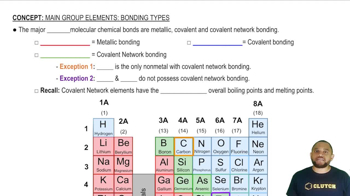Textbook Question
Show the direction of polarity for each of the bonds in Problem 7.51 using the notation.
(b) Si-Li or Si-Cl
855
views
 Verified step by step guidance
Verified step by step guidance



Using only the elements P, Br, and Mg, give formulas for the following. (a) An ionic compound
Using only the elements Ca, Cl, and Si, give formulas for the following. (a) An ionic compound